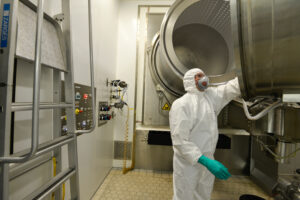
Ergonomics at the workstation
Seqens is committed to a program to improve workstation ergonomics and reduce accidents related to manual handling.
Manual handling exposes SEQENS employees to the risks associated with physical activity. Carrying, moving, pushing, pulling, lifting, and placing loads involves physical effort and biomechanically demanding postures. Performed repetitively, at a sustained pace and/or in poor conditions, manual handling is the cause of many occupational accidents and diseases, the most well-known of which are MSDs (Musculoskeletal Traumatism).
The reduction of risks generated by handling operations is a strong concern as these operations represent more than 50% of the causes of accidents at SEQENS over the last 3 years.
A program to identify and minimize risks
In addition to the mandatory “Gestures and Postures” training courses, Seqens is committed to a program to improve the ergonomics of handling operations. Working groups have been set up in each of the production sites. These working groups have benefited from the support of an ergonomist and are responsible for carrying out analyses of workstations according to an established program. The ITAMAMI method, created by the CARSATs (french Pension and Occupational Health Insurance Fund), makes it possible to formalize the observation and analysis of work situations by collecting elements on all facets of the operators’ activity.
The aim is to identify high-risk positions, set priorities, study these positions using an ergonomic approach, develop and prioritize recommendations and monitor their implementation.

To describe the actual work, the method classifies the elements of the work situation into five categories:
- I – Individual: Who? Who are you?
- T – Task (“prescribed” work): What? What tasks do you have to perform?
- A – Activity (“real” work): How? How do you do it?
- MA – Material: With what? What are you working with?
- MI – Environment: What Environment. Where do you work? When do you work? Who do you work with?
The observation of the work situation consists in questioning each of these 5 components. A precise note-taking takes place during the sequences of observations and exchanges with the operators. Photos and/or videos are used for analysis and to illustrate the findings and recommendations.
Following these observations, the working group :
- Analyses the observed work situations according to the ergonomic approach.
- Develops a summary document of the highlights identified.
- Proposes improvements and complementary prevention measures:
- Technical = handling assisting devices
- Organizational = work organization and communication actions.
- Human = information, awareness and training actions.
The choice of prevention measures takes into account their effectiveness in reducing or even eliminating exposure to risks.
The detailed methodology is described in a Good Handling Practices guide. This approach has already led to substantial improvements; the Seqens Group is continuing its efforts to analyze and improve workstations with high physical activity levels.

